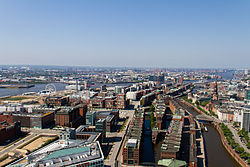Our website is made possible by displaying online advertisements to our visitors.
Please consider supporting us by disabling your ad blocker.
HafenCity
This article has multiple issues. Please help improve it or discuss these issues on the talk page. (Learn how and when to remove these messages)
|
HafenCity | |
|---|---|
 Aerial view of western HafenCity and Speicherstadt (2013) | |
| Coordinates: 53°32′30″N 9°59′36″E / 53.54167°N 9.99333°E | |
| Country | Germany |
| State | Hamburg |
| City | Hamburg |
| Borough | Hamburg-Mitte |
| Area | |
• Total | 2.4 km2 (0.9 sq mi) |
| Elevation | 8 m (26 ft) |
| Population (2023-12-31)[1] | |
• Total | 7,362 |
| • Density | 3,100/km2 (7,900/sq mi) |
| Time zone | UTC+01:00 (CET) |
| • Summer (DST) | UTC+02:00 (CEST) |
| Dialling codes | 040 |
| Vehicle registration | HH |
| Website | www.hamburg.de |
HafenCity (German pronunciation: [ˈhaːfn̩ˌsɪtiː] ⓘ) is a quarter in the borough of Hamburg-Mitte, Hamburg, Germany. It is located on the Elbe river island Grasbrook, on the former Port of Hamburg area. It was formally established in 2008 and also includes the historical Speicherstadt area, which since 2015 is an UNESCO World Heritage Site with the adjacent Kontorhausviertel. The main landmark of the HafenCity is the Elbphilharmonie concert hall.
In a narrower sense, HafenCity Hamburg is a project of urban regeneration where the "greater Grasbrook" area of the former Hamburg free port is being revitalised with new hotels, shops, office buildings, and residential areas. The project is considered the largest urban redevelopment project in Europe by landmass, at approximately 2.2 square kilometres (220 ha). With the diminished economic importance of free ports in an era of European Union free trade, large container ships, and increased border security, the Hamburg free port was downsized,[2] relieving the current HafenCity area of its restrictions. The ground-breaking ceremony was held on 20 June 2001, with the first quarter called "Am Dalmannkai/Sandtorkai", neighboring the Elbphilharmonie, completed in 2009.
When completely developed, the HafenCity area is projected to be home to about 12,000 people and the workplace of 40,000 people.
- ^ "Bevölkerung in Hamburg am 31.12.2023 nach Stadtteilen". Statistisches Amt für Hamburg und Schleswig-Holstein. May 2024.
- ^ Rahman, Rakin (2023-02-21). "Geopolitics impacts Port of Hamburg as container volume drops". Port Technology International. Retrieved 2023-03-16.
Previous Page Next Page





